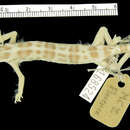Brief Summary
(
الإنجليزية
)
المقدمة من EOL authors
Coleonyx variegatus bogerti is a small lizard with lengths up to 12.7 cm (5.0 in) STL (snout-tail length), with almost half this length from the tail. Average SVL lengths in Hidalgo Co., New Mexico (Degenhardt et al. 1996) were 5.2-6.4 (5.6) cm for 40 males and 5.2-6.7 (58.5) cm for 24 females. Average lengths reported (unknown if STL or SVL) for the species varies widely from 4.5-6.0 inches in Behler and King (1979) to 2.0-3.0 inches in Stebbins (2003) and Brennan and Holycross (2006). The skin is soft, somewhat translucent, and covered in granular scales; tubercles absent. The coloration ranges from pinkish tan or tan to cream, with dark reddish brown crossbars or reticulations; the underside is usually a plain pale yellow to cream color. The head has dark brown to black spots, and a light-cream color line starts from under each eye passing just above the ear opening and ends in a loop on the back of the neck. They have a pointed snout, protruding moveable eyelids and large eyes with vertical pupils. The tail is usually plump and becomes constricted where it meets the body; if unregenerated, it is about as long as the body and has bar markings. The legs are small and the toes are slender with no pads or villi. Young usually have distinct crossbars that break up into reticulations as the animal ages. C. v. bogerti in SE Arizona tends to retain the juvenile pattern (i.e. crossbars). Males develop large hemipenal bulges and posses a pair of spurs at the base of their tails. (Behler and King 1979; Degenhardt et al.1996; Stebbins 2003; Brennan and Holycross 2006). It's range is southeastern Arizona and extreme southwestern New Mexico into northern Sonora, Mexico. Coleonyx variegatus bogerti is a nocturnal ground dweller active between April and October. Adults are normally active just after dark and remain so throughout the night. They hibernate during the winter months between November and March when temperatures drop too low, and live off the fat stored in their tail. During warmer months, they avoid the heat of the day by hiding in rock crevices or under logs, fallen limbs, or rubbish. Defensive tactics observed by Coleonyx variegatus bogerti include squeaking, ejecting viscous liquids, and limb extension (SDNHM, 2007). Geckos are able to detect and identify potential snake predators by chemical means (Dial et al., 1989 in Degenhardt et al. 1996). When threatened, Coleonyx variegatus bogerti may use specific behaviors that draw the predator’s attention to their tail instead of the body, such as curving their tail over their back and wiggling it back and forth. Some think this gives them the impression of a large scorpion. If caught by the tail, they will readily lose it. However, the tail is easily regenerated but can be costly for the geckos physically during the winter, since the tail holds their main fat reserve. They also wave their tail in a feline manor when hunting or stalking their prey (Behler and King, 1979). Banded geckos are known to mark out discrete locations some distance away from their daytime retreats for defecation. The scent of chemicals in the feces may serve as a social “signpost” to other geckos, notifying them of the resident’s occupancy. Lifespan in captivity has been reported between 7 to 10 years (Geckos Unlimited 2001), and also 15+ years (Geckoweb 2007). The species is an invertivore, consuming insects such as beetles, grasshoppers, insect larvae, termites, and solpugids and spiders. Inhabits arid habitats in canyons, around rocky outcrops, washes, and sandy areas.

